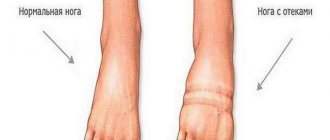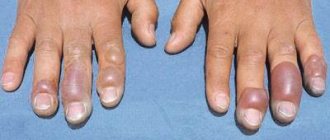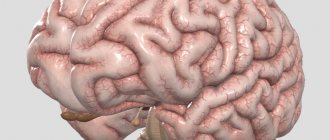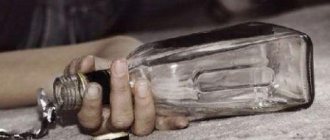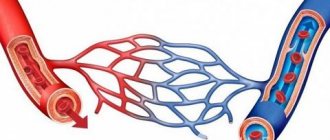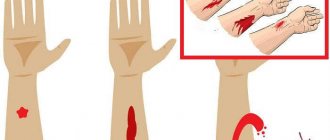Snow, ice and gusty winds - real winter has come to Moscow. Last night the temperature in the city dropped to minus 12–14 degrees. During the day, the thermometer will show eight to ten degrees below zero.
From the middle of the week the frosts will subside, but the temperature will remain several degrees below normal. In such weather there is a high risk of hypothermia and frostbite. Hypothermia can cause both local and general cold injury, and deep frostbite can lead to disability.
Interesting information about hypothermia
Here's what's useful to know about the condition of hypothermia:
- Most often, people who are intoxicated suffer from hypothermia.
- It doesn’t have to be -30° outside to get hypothermia. You can freeze even at above-zero (less than 10°C) temperatures if you go out in wet clothes, lose more than 700 ml of blood beforehand, or undergo treatment for a cancerous tumor.
- The main “responsible” for thermoregulation (regulation of body temperature) is the hypothalamus. It is also the main endocrine organ.
- The spinal cord and the two terminal sections of the brain (medulla oblongata and midbrain) are also involved in thermoregulation. With their pathologies, hypothermia occurs much faster and even when the air temperature is not too low.
- If it’s 35° outside, then if you don’t move, your body temperature will drop by 1° approximately every 30 minutes.
- When you no longer care that you are freezing in the snow, and you no longer want to go looking for housing, it means that your body temperature has reached 32.9°.
- If it has become impossible to move, the joints seem to be constrained, the body temperature has reached 32.2° or lower.
- At 31.1°, trembling stops, with the help of which the body tried to warm up. Shivering doubled the amount of heat, but at this temperature it became an additional waste of energy, which is already in short supply.
- From the moment of falling to the ground without force, a person no longer remembers almost anything: the body turns off those parts of the cerebral cortex that are responsible for memory to save energy.
- Hypothermia is most dangerous for children from 1 month to 6 years old: their thermoregulatory systems have not yet matured.
- Newborns, oddly enough, tolerate cold much better than adults, although they do not yet know how to shiver to increase their temperature. They are protected by brown adipose tissue, which reaches its maximum amount (5%) before the age of 28 days. It is located in the neck, back, shoulders, and also near the kidneys.
- For some time, at low air temperatures, brown adipose tissue produces heat, but in an adult there is not much of it.
- The amount of brown fat increases in people who exercise.
- It is believed that if the body temperature reaches 24°, then the person can no longer be saved. However, during heart surgery, body temperature is reduced to 20°, which makes it possible to operate with the artificial blood circulation machine turned off for no more than 17 minutes.
- The pre-death symptom of a frozen person is considered to be a feeling of heat.
It is also interesting to know that the body is supplied with heat due to:
- muscle work (trembling). It increases the amount of heat in the body 3-4 times more than when walking, while the actively contracting muscle itself warms up by 2° or a little more. During heavy physical work, heat is generated 2-2.5 times more than during trembling;
- increasing the minimum required energy required for the functioning of all organs. These processes are regulated mainly by the thyroid gland, so in people with hypothyroidism hypothermia occurs faster;
- energy consumption of adipose tissue (therefore, overweight people are less likely to die from hypothermia);
- acceleration of chemical processes in the liver, thanks to which the body is partially provided with energy;
- increase in heart rate. This, by analogy with skeletal muscles, increases the amount of heat in the body;
- active inclusion of additional areas of the brain and kidneys;
- eating food that produces energy when broken down;
- attempts to reduce the area of the body that is in contact with the environment (similar to curling up into a ball);
- reduction of blood supply to the periphery, that is, skin, subcutaneous tissue, skeletal muscles, especially on the extremities. The first to “turn off” is the skin and the sweat glands contained in it, the task of which is to increase the evaporation of heat from the surface of the body;
- decreased breathing, which also causes heat evaporation;
- an atavistic reaction of “raising the fur”, due to which the layer of warm air around the body would increase. In humans, it looks like “goosebumps” or “goose bumps”.
Hypothermia and first aid for it
If due to unfavorable weather conditions a person has suffered from hypothermia, then you need to call an ambulance and briefly describe the victim’s condition. Then immediately provide first aid at the first signs of hypothermia, which consists of the following measures:
- Move the victim away from the source of hypothermia.
- Change into dry clothes.
- Take a napkin moistened with alcohol and rub the limbs.
- Fill a basin with water, the temperature of which should be 37 degrees, lower the limbs. The water temperature can be increased gradually so as not to harm the person.
- Start rubbing the skin until sensitivity returns.
- Apply a dry cloth to the frostbitten areas of the body and wrap the person in a warm blanket.
- When hypothermia occurs, the vessels become fragile and brittle, so it is necessary to ensure maximum immobility of the limb.
- Give the person warm liquid to spread heat throughout the body.
All these actions in case of hypothermia must be taken before the ambulance arrives. Depending on the condition, actions may vary.
The most important thing is to provide the person with comfortable conditions, move him to a warm room, and try to make sure that the victim does not fall asleep.
In this state, a person constantly feels sleepy, but if he falls asleep, energy will stop being produced, and the body will no longer be able to fight. If you don’t panic and provide help, you can save a person’s life.
What leads to hypothermia
Hypothermia is caused by:
- subzero temperature;
- high air humidity;
- high wind speed (with a wind of 5 m/s, heat from the body evaporates twice as fast, at 10 m/s - 4 times);
- insufficient clothing;
- lack of a hat and/or gloves;
- shoes with thin (less than 1 cm) soles, rubber or tight shoes;
- synthetic clothing in the cold season;
- prolonged lack of movement on the street;
- intoxication, in which the vessels dilate, warmer blood from the “core” goes to the cold “periphery” and cools there, after which it goes to the “core” and reduces its temperature. That is, cooling occurs faster. In addition, reactions in the cerebral cortex are inhibited when intoxicated, so a person may fall asleep in the cold and not wake up.
The risk of hypothermia is higher in people who:
- follow an unbalanced diet;
- do not take enough vitamins;
- malnourished;
- overtired;
- live in a state of constant stress;
- Constantly decreased blood pressure is noted;
- exhausted, for example, as a result of a long illness. As a result, the amount of adipose tissue from which the body can draw energy in the cold is sharply reduced. The volume of muscle tissue also decreases, that is, shivering no longer warms you as much;
- have heart disease complicated by heart failure, when it is very difficult for the heart to pump blood that thickens in the cold;
- suffer from cancer;
- Addison's disease (adrenal insufficiency) is noted, in which blood pressure is constantly reduced, that is, the speed at which blood passes through the systemic and pulmonary circulation is reduced;
- HIV-infected;
- have low hormonal activity of the thyroid gland or reduced tissue sensitivity to these hormones. This condition, hypothyroidism, is itself accompanied by a decrease in body temperature, and low air temperatures only further aggravate it;
- suffer from cirrhosis of the liver, when normal liver tissue is replaced by fibrous tissue (similar to scar tissue);
- lost blood, especially acutely (that is, a lot at once). Constant (chronic) blood loss causes compensatory reactions in the body;
- received a traumatic brain injury accompanied by loss of consciousness.
Signs
Symptoms of hypothermia depend on its severity. The following degrees of hypothermia are distinguished:
- Mild – characterized by a decrease in body temperature to 32–34 degrees. The patient's blood pressure remains within normal limits. Experts can record the occurrence of 1st or 2nd degree frostbite. Mild hypothermia in the patient is accompanied by trembling in the body, awkwardness of movements, clouding of consciousness, increased pulse rate, breathing, forgetfulness, blurred speech, pale skin, apathy, and lethargy.
- Average - body temperature drops to 29–32 degrees. A person experiences a decrease in heart rate (up to 50 beats/minute), blood pressure, breathing becomes rare and shallow. Moderate hypothermia is manifested by patient disorientation, lack of mobility, memory loss, heart rhythm disturbances, bluish discoloration of the skin, drowsiness, severe tremors and muscle tension.
- Severe - temperature drops below 29 degrees, pulse slows to 36 beats/minute. With this degree of hypothermia, frostbite can occur, which threatens the life of the victim. The pathological condition is accompanied by dilated pupils, cardiac arrest, a persistent decrease in blood pressure, slowing of the pulse, breathing, convulsions, nausea and vomiting, and lack of normal brain functioning.
How does hypothermia manifest?
Symptoms of hypothermia appear gradually, depending on the level to which the body temperature drops.
When the temperature reaches 36.1-36.0°, a person can feel his muscles tense, especially in the neck area. They prepare to work, tremble, providing a person with the necessary warmth. The consciousness is clear, there may be a fear of freezing to death, but in the head there is some kind of action plan to solve this problem, and the person is actively implementing it. This stage is not yet considered hypothermia, but already requires getting into heat as soon as possible.
When the body has cooled to 35°, severe trembling begins and panic intensifies. The muscles are no longer so obedient and flexible, so it becomes more difficult to maneuver on the snow, even on skis. My knees bend badly, my arms are also frozen. Such muscle strain causes pain after hypothermia, but a body temperature of up to 34° is not considered hypothermia. Pain during hypothermia itself occurs already at its 2nd degree, and is associated with the fact that frozen muscles stiffen and become hard. Nerve endings, in contact with such muscles and other soft tissues that have undergone similar changes, are strongly stimulated. This is what causes pain.
In the meantime, the person is actively, under the influence of panic, working with his hands and feet to get into the warmth. As long as he moves and doesn't fall into the snow, and his clothes are sealed and not soaked in sweat, he can still avoid "real" hypothermia and all its consequences.
1st degree
At 34° the condition called hypothermia begins. It is divided into 4 degrees.
1st degree of hypothermia is a body temperature from 34 to 32°. It is also called the dynamic stage. Human skin is pale due to vascular spasm, and there is “goose bumps” throughout the body. You can still move, but it turns out badly: your arms and legs bend worse and worse. Breathing and heartbeat are still rapid, but from 34 to 32° they decrease more and more. Blood pressure has already been reduced. Consciousness is no longer clear: a person can look at the clock and forget what time it is, often commits rash actions (for example, moving in the opposite direction), but panic is gradually replaced by fatigue and indifference to the environment.
2nd degree
2nd degree of hypothermia or 2nd, stuporous stage, begins when the temperature drops from 32 to 29°. Signs of hypothermia at this stage are as follows.
Drowsiness increases, and trembling stops at 31.1°. The blood thickens, it becomes difficult for the heart to pump it, it begins to beat less frequently, about 50 beats per minute. At a temperature of 30° the heartbeat becomes arrhythmic. The skin is blue due to the lack of blood supply in it, the consciousness is clouded, it is impossible to move. If the victim is called by name, he may still try to nod, but he is not able to recognize his acquaintances or answer. Visual and auditory hallucinations appear.
The kidneys are still working. It’s difficult for them: they need to process a larger volume of blood than before, because the peripheral vessels are already “closed”, and all the blood is in the central vessels. Against the background of foggy consciousness and hallucinations, a person feels the urge to urinate. He imagines that nothing will happen if he starts to urinate just like that, and he does this, allowing the cold to penetrate his body even deeper and faster.
At a temperature of 29.4°, the remnants of consciousness are still present, but there is a feeling of intense heat, which the victim perceives as being saved and warmed up. In an attempt to get rid of the fever, he undresses, which is why this strange phenomenon is called paradoxical undressing. It is why people in hypothermia are mistaken for victims of sexual assault.
3rd degree
The temperature rapidly drops to 29°, and then 0.2-0.3° lower. A person, moving to the 3rd degree (it is considered from 29 to 24 or 25°), lying naked in the snow, suddenly realizes that he is alone, help has not come, and he has made many mistakes. After this, consciousness fades away. A superficial coma develops when tactile and painful stimuli cause minimal motor reactions in a person, without opening the eyes. His skin is bluish and swollen, his heart rate is no more than 40 per minute, his breathing is rare and shallow. Convulsions and vomiting are observed.
4th degree
If all 3 stages described above were reversible, then degree 4 or, according to another classification, the convulsive stage, is irreversible damage. This is severe hypothermia.
Body temperature – 25° and below. Here, all the mechanisms that tried to maintain life were exhausted. Various areas of the brain lost connections with each other, and areas of seizure activity appeared in the motor cortex.
The skin at stage 4 is blue, with a yellow tint, and looks like wax. The body cannot be straightened. There is no consciousness - deep coma: even if you call a person loudly or slap his cheeks, he will not react with a grimace or movement. The pupils are dilated. Periodically, the whole body is unbent by a spasm. Breathing is weak, rare and irregular (it may not even be visible). Heartbeat – 20-25 beats per minute, arrhythmic.
It is believed that death occurs at a body temperature of 23-24°. But there is a case where an adult survived freezing to 16°. The survival of a 2-year-old girl who spent the whole night on the street, where it was -40°, is also described. And although her body cooled to 14° and she had frostbite on her hands and feet, she managed to survive.
What is hypothermia
The body has an automatic thermoregulation system - maintaining a constant body temperature. The skin contains many cold receptors, which, when its temperature drops below 32°C, send signals to the corresponding centers at the base of the brain. From there comes a protective “command” to the autonomic nervous system - blood vessels dilate, blood flow increases, tissues warm up.
However, this mechanism is not unlimited. When the skin temperature drops to +12°C, the recipes are blocked and stop “working”. As a result, blood circulation and all life processes in the cooled area are reduced, and frostbite develops. At the same time, general hypothermia of the body occurs - hypothermia, it depends on how long the body was exposed to cold.
At the very beginning, when the protective mechanism sends blood to the cooled areas, this lowers the overall body temperature. Later, when the protective reaction no longer works, against the background of the existing cooling, vasoconstriction occurs, insufficient blood supply to all organs and tissues.
The result is the extinction of all vital functions, general freezing, which, if timely assistance is not provided, has a fatal outcome.
First aid
If you were walking with your child in a stroller and, when you came home, you found that his body, or just his legs, were cold, while the baby woke up normally, was not restless and did not refuse to eat, you need:
- start drawing water at a temperature of 37-38° into the bath (if only the legs are cold, then a plastic basin will do, where you will warm only them);
- remove cold clothes from the child, put him under a blanket;
- with warm hands, begin to rub it with gentle but active movements, under the blanket;
- give him warm sweet tea or mixture (whatever he will drink);
- warm it in a bath or basin for 15-20 minutes;
- wipe dry;
- wear warm clothes.
The same measures are carried out in case of mild hypothermia in both older children and adults.
In severe cases, first aid should:
- turn out competently, since most victims die during warming, when all the capillaries expand sharply, and blood rushes sharply from the center to the periphery - the pressure drops to critical figures - the blood supply to the brain ceases;
- turn out to be, despite the fact that there are no signs of life. The fact is that cold slows down all chemical reactions, including in the brain. Thus, the brain has enough even minimal volumes of blood to live. In addition, even with completely stopped blood circulation, the body can live for some time (remember the cardiac surgeries discussed at the beginning).
First aid for hypothermia consists of the following measures:
- Remove wet clothing from the victim, if possible; shake off the snow.
- Call an ambulance, saying that they found the victim due to hypothermia.
- Wrap the person in a warm blanket/long jacket/sleeping bag, put a hat on his head, and mittens on his hands.
- Carry the person to a warm room - on a stretcher or blanket, without straightening the body bent in the fetal position.
- If a person is experiencing convulsions, when transporting indoors, one person should walk in front, near the victim's head, observing his respiratory tract. He needs to either insert a small piece of cloth rolled into a roller into the mouth of a hypothermic person (so that it does not cover the mouth), or, when convulsions develop, pull the corners of the lower jaw and chin so that the lower teeth are in front of the upper ones.
- If there is no pulse and breathing in the room, begin performing resuscitation measures: 100-120 presses on the chest with the palms of straight arms, with 30 presses alternating with 2 breaths into the victim’s mouth or nose.
- If the person is conscious, try taking his temperature if you have an electronic thermometer. It needs to be inserted to a shallow depth into the rectum.
- A low body temperature indicates that it is now impossible to give a person water and hot food: the intestines have been turned off, and along with the hot water poured in, a lot of substances formed during intestinal ischemia will enter the blood. This can cause shock, which cannot be treated without medical help.
- At a temperature of 31° or higher, give a warm (2-3° above body temperature) non-alcoholic drink (tea, low-fat broth) or water.
- If a person is conscious, he needs to apply heating pads (plastic bottles) with warm water or an electric blanket to the area of the liver, femoral arteries (at the very top of the thighs, just below the inguinal fold), and axillary arteries. The water should be warm, and the heating pad or plastic bottle should be wrapped in a dry, clean cloth.
- Wrap the victim in a blanket until the medical team arrives.
- A conscious person should not be allowed to get into a hot bath (only one whose temperature is 1° above body temperature, with a gradual increase) or to warm his hands under hot water. Under no circumstances should a person be placed in such water if he is unconscious: the point is not that he will drink water, but that a sharp expansion of the capillaries will cause a drop in blood pressure (this is called shock), and its treatment without medical assistance impossible.
Acute hypothermia cannot be treated in any way:
- rubbing with snow or some hard objects. You can massage only with your hands, with light movements;
- pouring hot/warm liquid into the mouth of an unconscious person;
- giving warm liquid to a person whose body temperature is below 31°;
- straightening bent joints with rough movements. This is justified only when performing cardiopulmonary resuscitation if the victim’s hands prevent him from reaching the chest;
- placing a person in a bath of hot water.
Signs of hypothermia
It's not that difficult to recognize. At first, a person experiences a surge of energy, he is overly excited, but at the same time there is a cyanosis of the nasolabial triangle and paleness of the skin. The patient is worried about severe chills, shortness of breath, and rapid pulse.
If no therapeutic measures are taken during this period, excitement is replaced by apathy, lethargy, and lethargy. A person loses the ability to move, becomes weak and drowsy, and often loses consciousness. Failure to provide assistance in case of hypothermia leads to the cessation of cardiac and respiratory activity, as a result of which the person dies.
Who needs to be hospitalized
It is clear that treatment of hypothermia in a hospital is necessary if the victim is found unconscious or without signs of life. But hospitalization will be mandatory if:
- a child or an elderly person has become hypothermic;
- the victim was at 2-4 degrees of hypothermia;
- an arrhythmic pulse was determined;
- there is frostbite of the extremities of any degree, while the person suffers from diabetes mellitus, he has obliterating endarteritis or atherosclerosis of the lower extremities, trophic ulcers;
- there is frostbite of any parts of the body that have 3 or 4 degrees.
Rewarming and complications
With sharp peripheral vasodilation, arrhythmia and cardiac arrest may develop in several ways: 1. “Acidic” blood from the peripheral vascular bed due to active metabolic processes reaches the “core” of the body, which leads to the development of acidosis. As a result of acidosis, the content of catecholamines in the blood increases, which potentiates increased cardiac activity, increased heart rate, and increased blood pressure. Increased acidosis reduces the sensitivity of receptors to adrenergic substances, and arrhythmia may occur. 2. Due to myocardial damage, hypovolemia, after peripheral vasodilation, blood pressure decreases, which leads to the development of shock. 3. Cold blood from the peripheral parts of the bloodstream reaches the “core,” which leads to increased hypothermia, i.e., a further decrease in the temperature of the “core.”
Treatment in hospital
Medical assistance is as follows:
- placing the patient on a mattress with warm water;
- intravenous administration of solutions heated to 37° (or higher);
- if resuscitation was performed, administer a small amount of soda;
- ensuring adequate breathing: conscious patients are given humidified oxygen through a mask, unconscious patients are necessarily put under therapeutic anesthesia using sodium hydroxybutyrate and sibazon, after which they are put on breathing using a ventilator;
- if necessary, defibrillation;
- if the patient is found in stage 3 hypothermia, he is connected to a heart-lung machine, which will warm the blood by 1° every 3 minutes. If this is not possible, you can resort to surgical intervention - washing the internal organs with a warm solution of sterile saline with a gradual increase in the temperature of the liquid;
- drugs are administered to improve heart function;
- if necessary, an artificial pacemaker with defibrillation function is installed;
- after the danger of fibrillation has passed and the heart rhythm has been restored, antispasmodics can be administered, the task of which is to eliminate vascular spasm;
- if, after hypothermia, an arm, leg or any other part of the body hurts, which is caused by prolonged muscle spasm and frostbite, be sure to administer painkillers;
- In addition, the victim receives vitamins, antihistamines, and drugs that improve nutrition specifically for the heart.
After the victim is admitted to the hospital, the temperature after hypothermia must be monitored. The measurement is carried out in the rectum using electronic sensors. At first, body temperature decreases, as the skin and subcutaneous tissue, remaining cold, cool the entire body. After a while it should start to increase. Doctors find the optimal speed for administering solutions (if there is no heart-lung machine) so that the temperature rises by 1 degree every 15 minutes.
Other indicators are also monitored: pulse, number of respirations, blood pressure. Very often, an ECG is taken or a heart monitor is installed to constantly monitor the heart rhythm.
Treatment of hypothermia
Treatment for a patient suffering from hypothermia includes:
- carrying out the first medical measures;
- if necessary, forced ventilation;
- administration of drugs that support the cardiovascular system;
- carrying out inhalation with heated oxygen;
- internal warming using infusion therapy with warm solutions;
- prescription of painkillers;
- administration of sedatives to relieve tension and anxiety;
- in case of severe hypothermia, the stomach and bladder are washed;
- To prevent the occurrence of purulent complications, antibacterial drugs are prescribed.
However, despite the intervention of doctors, the consequences of hypothermia can include diseases of the respiratory system, inflammation of the pelvic organs, nervous system disorders, “cold allergies” and tissue necrosis caused by frostbite.
And in most cases, when a person’s body temperature drops below 28 degrees, he dies from hypothermia due to the cessation of cardiac activity.
Complications of hypothermia
The consequences of hypothermia are very serious. This:
- pneumonia;
- frostbite of body parts;
- diseases of the ENT organs: sinusitis, tonsillitis, laryngitis;
- ARVI, including influenza;
- exacerbation of chronic diseases, increasing the severity of their course.
It often happens that a person died from hypothermia: from cardiac arrest, from sudden warming, from ventricular fibrillation that occurred during warming, from severe frostbite of the extremities.
In medicine, hypothermia is the effect of cold on the entire body. But people also use this word to refer to local cooling of individual organs. This condition is fraught with its own complications.
So, hypothermia of the head is isolated. In this case, the blood vessels of the head spasm, which is manifested by headache, dizziness, a condition that is described as “the head has become cloudy.” Such hypothermia is fraught with:
- ARVI;
- development of sinus inflammation;
- worsening of the course of vegetative-vascular dystonia;
- increasing the degree of hypertension;
- meningitis (inflammation of the meninges);
- hair loss;
- the appearance of dandruff;
- development of inflammation of the trigeminal or facial nerve;
- hearing impairment due to inflammation of the ear structures.
It requires appropriate treatment from a therapist.
Hypothermia of the feet can be complicated by:
- colds;
- frostbite of the extremities;
- inflammation of the uterine appendages;
- cystitis;
- pyelonephritis;
- pain in the joints of the legs.
If hypothermia occurs in the lower back, this is complicated, first of all, by inflammation of the kidney tissue. The second most common disease to develop is radiculitis. In addition, adnexitis, cystitis or prostatitis may develop.
People also use the term “dental hypothermia.” This refers to inflammation of the nerves that provide innervation to the teeth. This is the trigeminal nerve and its branches, the inflammatory process in which is accompanied by terrible twitching pain.
Neuritis of only that branch of the trigeminal nerve that goes to the teeth of the upper or lower jaw is not life-threatening. But very severe pain requires treatment with physiotherapy, painkillers and anticonvulsants by a neurologist.
Hypothermia of the teeth can also be called the appearance of a capsule with pus on the root of the tooth - granulomas. Its occurrence often occurs a few days after the first symptoms of ARVI appear. In this case, redness and swelling of the gum area are visible. This condition is treated by a dentist.
Symptoms of hypothermia
The main symptoms of hypothermia are:
- decreased skin sensitivity, numbness;
- severe pain when trying to warm or rub a frozen area of skin;
- numbness and necrosis of the fingers or toes, the occurrence of painful sensations in them during physical activity;
- the appearance of bloody blisters on the feet;
- in severe cases of hypothermia, dark spots may appear on frozen areas, indicating tissue death.
When general hypothermia sets in, the body tries to increase heat production, and the person feels a surge of strength.
But at the same time, the skin noticeably turns pale, the nasolabial folds become bluish, the pulse quickens, shortness of breath, severe chills, and clouding of consciousness appear.
In this state, it is already necessary to take urgent measures to restore the vital functions of the body.
Hypothermia in children
Hypothermia of a child does not always occur on the street if he is poorly dressed. This condition can develop when:
- lying in wet diapers for a long time;
- low air temperature in the room, despite the fact that the child is dressed inadequately;
- swimming in cold water;
- long walks in a stroller along the street in cold and rainy weather.
Hypothermia occurs in private homes, when the child can go directly outside. They are more likely to develop in children who have a poor and monotonous diet, suffer from anemia and rickets.
Symptoms of hypothermia in young children are:
- Behavior that is unusual for this child: calmness, silence;
- drowsiness;
- weakness;
- faster breathing and heart rate;
- cold skin.
If a child could go outside on his own and not be able to go in, his limbs will show signs of frostbite. There is no muscle tremors in children under 3 years of age.
First aid for children is provided on the same principle as for adults. The first point of assistance is to call an ambulance, which is done simultaneously with wrapping up the child, changing his clothes, and placing heating pads made from small plastic bottles on large vessels.
Symptoms that appear
To provide first aid, you should know the symptoms that appear so as not to harm your health. Signs of hypothermia can be briefly described:
- heavy rapid breathing;
- forgetfulness;
- excessive irritability;
- inability to clearly express thoughts;
- chills;
- drowsiness;
- aches throughout the body and a feeling of fatigue;
- pale and cold skin.
If at least one of these symptoms is observed in the victim, action should be taken to help with hypothermia. If it is not provided in a timely manner, the person will experience complications and other signs:
- the appearance of bluish skin;
- violation of the frequency and rhythm of the heartbeat;
- loss of sense of direction;
- severe frostbite;
- nausea and vomiting;
- loss of consciousness;
- disruption of the central nervous system;
- pupil enlargement.
To prevent complications and consequences of hypothermia, you should act clearly and quickly.
Prevention of hypothermia
It consists of many quite simple and logical rules:
- Dress appropriately for the weather.
- Clothes for the cold season should be made from natural fabrics and fur.
- Outerwear should not get wet.
- Do not drink alcohol outdoors during the cold season.
- In frost and strong winds, treat the skin of exposed areas with special fatty creams.
- In winter, you must have a hat on your head and warm gloves on your hands.
- Avoid wearing tight or rubber shoes in cold weather. If it rains, rubber boots are appropriate, but there should be a special fleece lining between them and the sock.
- The sole of autumn-winter shoes should not be thinner than 1 cm.
- Carry heavy objects in your hands only for short distances, or if possible, when you feel the first signs of chills, go to a store or cafe and warm up.
- If you are driving in bad weather, be sure to tell your friends or family your route. Agree on how long you need to be there so that they can call rescuers in time.
- Take a thermos or thermal mug, a packed lunch of nuts, raisins, dried fruits, a shovel, a phone battery, and dry alcohol into your car.
- In the cold season, especially off-road, it is better not to travel alone.
- Never drive off the road during a blizzard or snow. This gives you a chance to find you faster.
- If your car is caught in the snow, stop and do not get out of the car. You can get out only if the final destination is very close. And then, if you go, take with you a few bright things that you need to periodically place on the road, so that later (if necessary) you can find your way to the car.
- Fast walking, jogging in place, squats on a cold street help to warm up.
- Don't be shy about asking other people for help.
- Eat a hearty meal before going out/going outside.
- Do not wear earrings or rings in winter.
- Do not go out in the fall, winter and spring until May with wet hair.
Author:
Krivega Maria Salavatovna resuscitator
Consequences and methods of prevention
Only a mild degree of general hypothermia of the body can pass without a trace, and even then not always. Changes in organs and tissues associated with impaired blood circulation and a decrease in protective properties can lead to the following consequences:
- development of pneumonia, otitis - more often in children;
- inflammation of the joints, exacerbation of chronic polyarthritis;
- development of lymphadenitis - inflammation and hyperplasia of the lymph nodes;
- vegetative-vascular dystonia;
- inflammation of the urinary system (pyelonephritis, cystitis);
- increased sensitivity to cold.
In severe cases, dangerous complications can develop: acute cardiac, pulmonary and renal failure, from which the victim can die.
Preventing hypothermia is much easier than eliminating the consequences; its prevention consists of the following rules:
- avoid prolonged exposure to the cold;
- choose the right clothes and shoes for the season; they should not be tight;
- do not wear metal jewelry (bracelets, rings, earrings);
- do not go out into the cold without eating;
- Before going outside, lubricate your skin with a protective oily cream;
- eliminate alcohol consumption and smoking;
- do exercises, sports, hardening the body.
